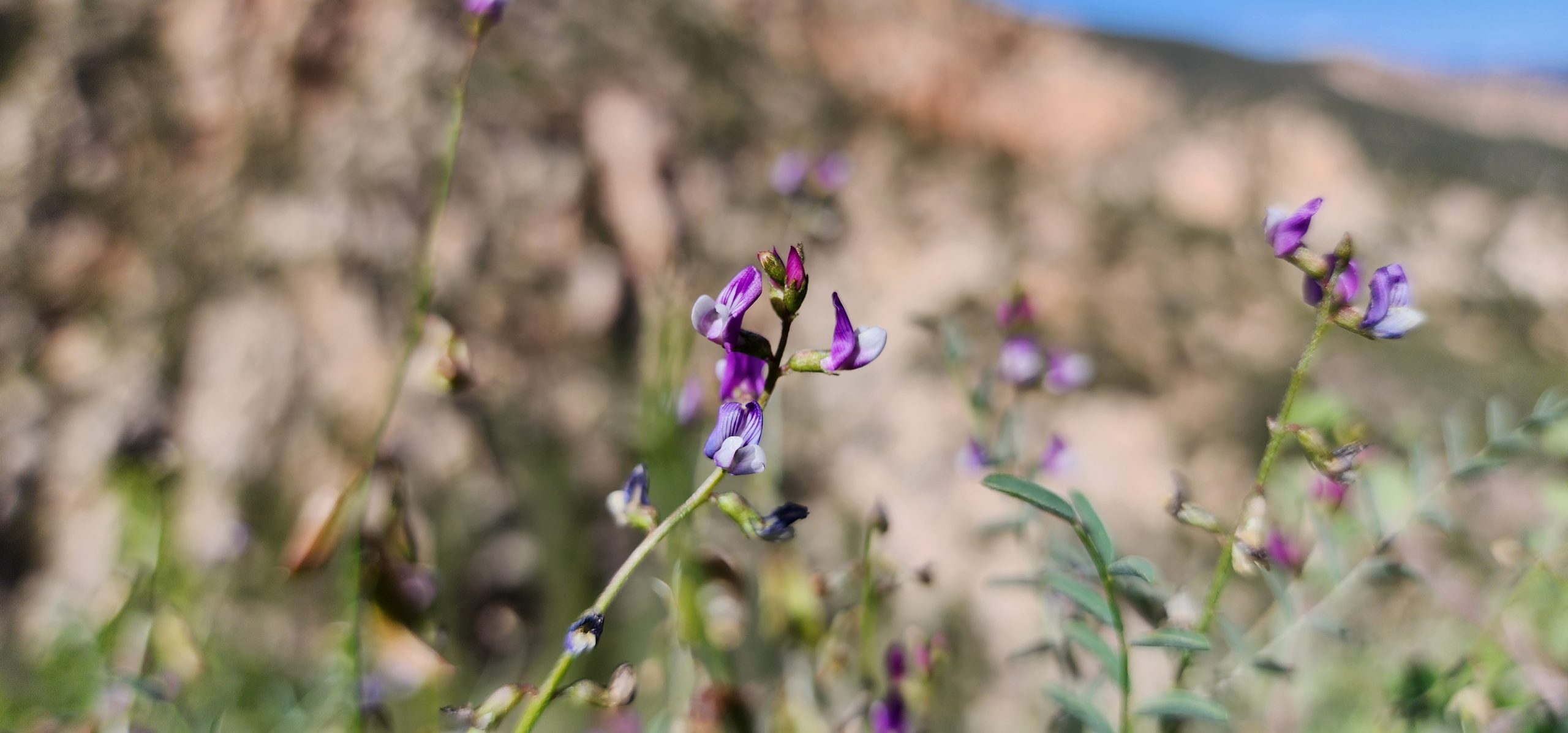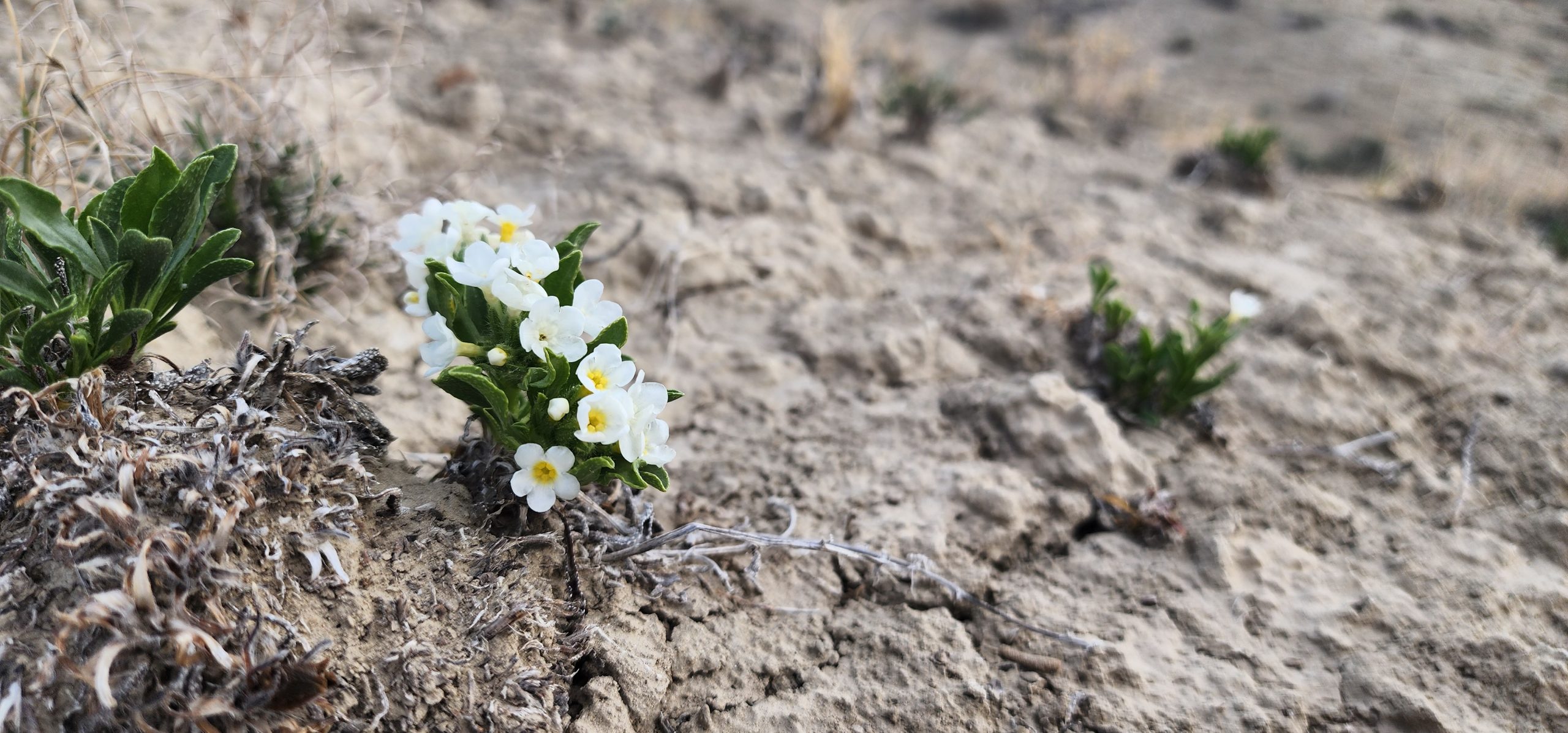Save Plants
Center for Plant Conservation
As we step into 2024, we are thrilled to welcome the hope, changes, and opportunities that a new year brings—and to embark on a milestone year in the Center for Plant Conservation’s (CPC) journey. This year marks our 40th anniversary year. We look forward to a year-long celebration of our organization’s remarkable history and conservation achievements to save plants from extinction, with an eye to the future and our next 40 years.
Over the past four decades, CPC and our network of Conservation Partners have made significant strides in preserving the imperiled native flora of North America. Co-founded in 1984 by graduate students Don Falk and Frank Thibodeau, and originally headquartered at the Arnold Arboretum of Harvard University, CPC has grown into a flourishing organization and network dedicated to the preservation of these precious species. As true today as when we were founded in 1984, it takes a village—our community of conservation practitioners and researchers, advisors and partners, donors, and plant enthusiasts—to bring CPC to where it is now and to support our conservation mission and vision.
The progress we’ve achieved is extraordinary—but as we look ahead, the urgency to save these species has never been greater. In honor of our 40 years of impactful conservation work, we are excited to announce the launch of a special ‘40 for 40’ fundraising campaign. Our goal: to raise $200,000 to sponsor 40 plant species in the National Collection, in honor of our 40 years of saving plants from extinction. This campaign is not only a celebration of the incredible milestones we’ve reached, but also a clarion call to action. The need to prevent the extinction of rare plants has never been more critical, and your support can make all the difference. We invite you to learn more about the campaign in this issue and to join us in celebrating CPC’s anniversary by sponsoring a rare plant.
We look forward to sharing more conservation stories and key initiatives from CPC and our Conservation Partners throughout our 40th anniversary year in our Save Plants newsletter—now in a bi-monthly format. And, of course, we will continue to spotlight the beautiful and diverse imperiled plants we are striving to save.
We are immensely grateful for the dedication, contributions, and unwavering support received throughout our first 40 years from individuals like you, who recognize the importance of preserving our planet’s botanical diversity. As our anniversary year commences, we invite you to join us in celebrating our accomplishments, recognizing the challenges and opportunities that lie ahead, and contributing to a future where plants, people, and our planet thrive.
Thank you for being part of our journey,
The Center for Plant Conservation Team
Celebrating 40 Years of Saving Plants
40 years ago, the Center for Plant Conservation (CPC) was founded as a one-of-a-kind network, uniting plant conservationists from botanical gardens, arboreta, and other plant-focused organizations that collaboratively work to save the rare and endangered plants of the United States, its territories, and Canada from extinction. Co-founded in 1984 by graduate students Don Falk and Frank Thibodeau at the Arnold Arboretum of Harvard University in Jamaica Plain, Massachusetts, CPC specializes in the conservation of native flora by utilizing ex situ—offsite, away from the wild population—curation techniques, such as collecting and banking seeds, growing plants from seed in nurseries, and establishing conservation best-practice protocols.
Falk and Thibodeau understood that we can save more plants by working together than would ever be possible alone. They strategically recruited botanical gardens throughout the country to engage in ex situ conservation of targeted rare plant species and to house them in their own conservation collections, including seed banks, nurseries, garden displays, tissue culture labs, and cryopreservation tanks. These ex situ collections form the CPC National Collection of Endangered Plants—an important conservation resource which serves as an emergency backup in the event a species becomes extinct or no longer reproduces in the wild. Initially, 14 botanical institutions joined CPC’s network: The Arboretum at Flagstaff, The Arnold Arboretum of Harvard University, Bok Tower Gardens, California Botanic Garden, Denver Botanic Gardens, Desert Botanical Garden, Fairchild Tropical Botanic Garden, Holden Arboretum, Missouri Botanical Garden, National Tropical Botanical Garden, Native Plant Trust, North Carolina Botanical Garden, Red Butte Garden, and Waimea Arboretum Foundation. Within three years, 200 species of rare plants had been secured in the National Collection.
Today, CPC—headquartered at the San Diego Zoo Wildlife Alliance in San Diego County, California—serves as a trusted authority and foremost resource in science-based best practices for the conservation of rare and endangered native plants. Our network of world-class botanical institutions has grown to 75 partners, and over 2,600 species are now safeguarded in the National Collection—bringing CPC more than halfway to our goal of securing all 4,400 rare North American plant species.
Sponsor a Plant in Honor of CPC’s 40th Anniversary
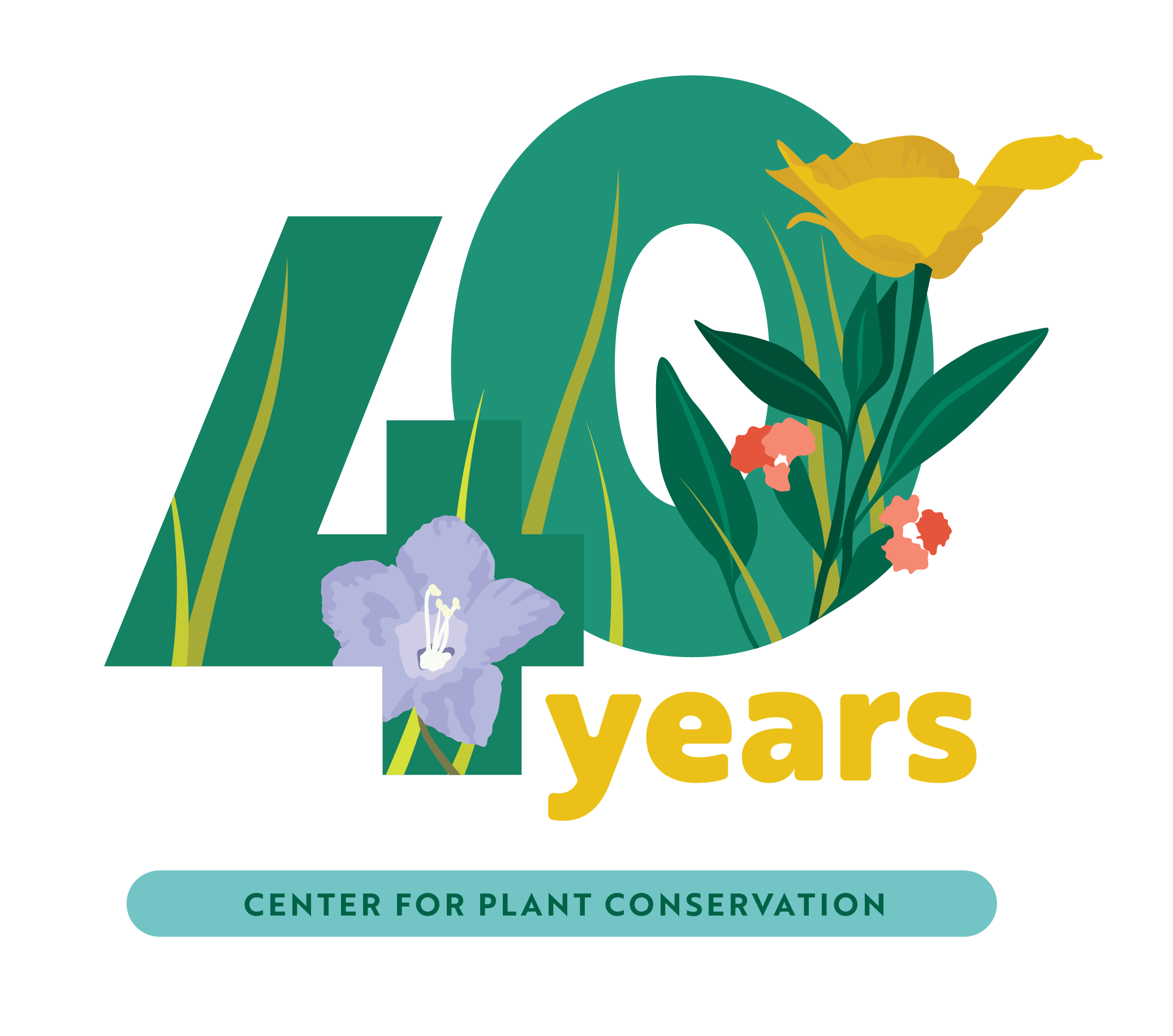
To celebrate our milestone 40th anniversary, CPC invites you to sponsor a rare plant in support of our ‘40 for 40’ campaign! Our goal: to raise $200,000 to sponsor 40 plant species in the National Collection in honor of our 40 years of saving plants from extinction.
We’ve curated a special selection of rare plant species in need of sponsorship as part of this 40th anniversary campaign—highlighting the incredible beauty and diversity of North America’s rare and endangered plants. From the iconic Venus’ flytrap of the Carolinas and the charming Estuary monkeyflower of the Northeast wetlands, to the radiant White fire-wheel of Eastern Texas and the towering Torrey Pines of Southern California’s coasts—there are an abundance of endangered plants that need your support!
Double the impact of your gift – every $5K raised will be matched to achieve a full $10K sponsorship! The CPC Board of Trustees has pledged $200,000 in matching funds for the ‘40 for 40’ anniversary campaign. For every $5K raised per plant species, our Board of Trustees will provide $5K in matching funds to bring the species to the full sponsorship level of $10K–growing the impact of your gift in support of rare and endangered plants. We are proud to have one hundred percent participation from our Board of Trustees for this match.
Plant sponsorships play a critical role in CPC’s mission to Save Plants from extinction. When a CPC Participating Institution (PI) accepts responsibility for a National Collection species, it makes a long-term commitment to steward the species for future generations. PIs invest significant resources and effort in securing and holding the imperiled plant material, and they advance research and new technologies on the best ways to grow, manage, and restore these rare species. To offset some of the expenses of collecting, growing, and researching these plant species, CPC created the Plant Sponsorship Program. Plant sponsorships provide the PI responsible for the named species with steady, reliable funding for long-term work. A sponsorship does not cover all the expenses, but it provides significant help and stability. By supporting the Plant Sponsorship Program, you are directly funding the stewardship of plants in the National Collection and aiding conservation work throughout CPC’s nationwide network.
____________________________________________________________
Meet the Plants
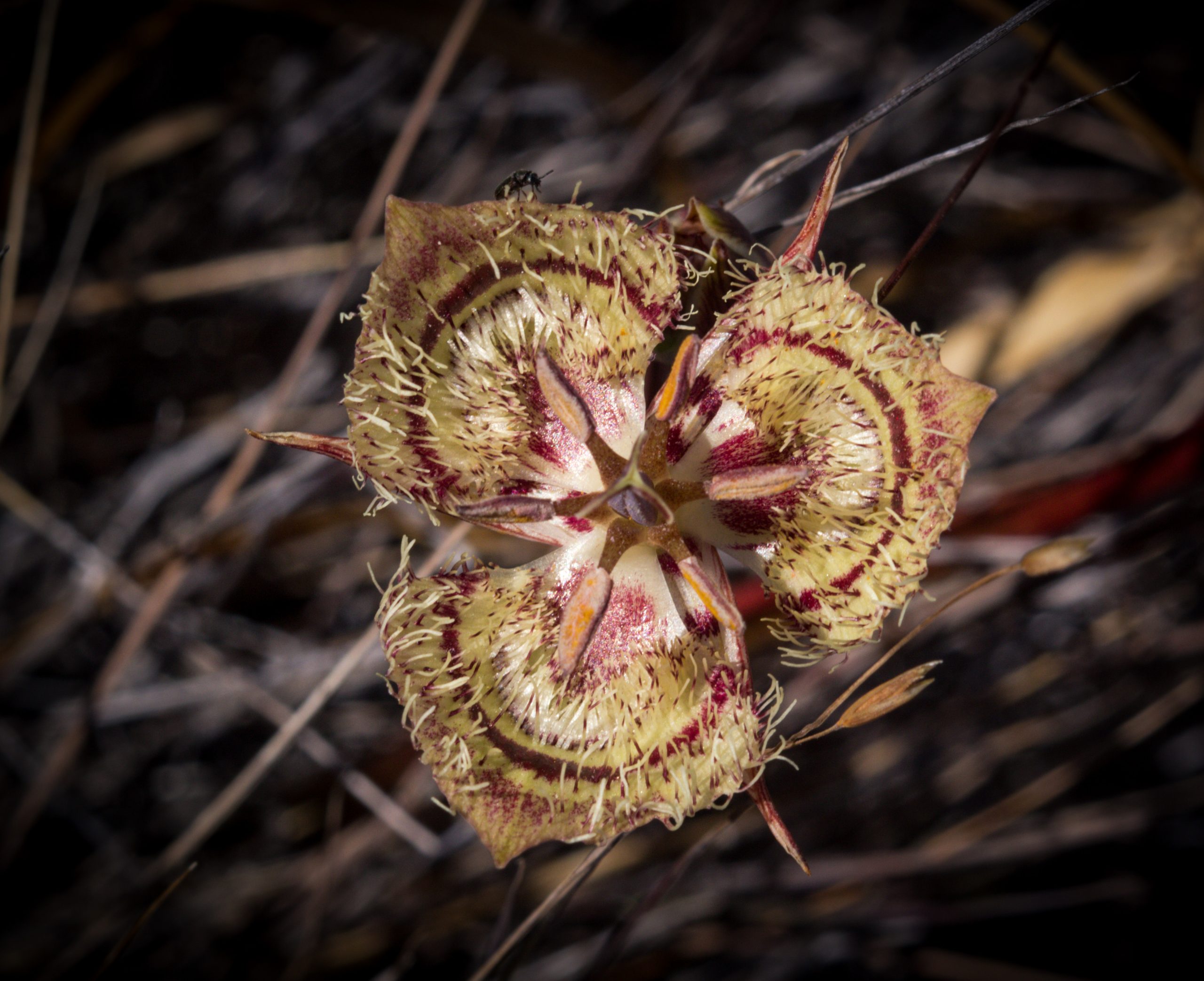
Tiburon Mariposa Lily (Calochortus tiburonensis) is a critically imperiled lily species endemic to a single summit on the Tiburon Peninsula in Marin County, CA. This California endemic lily boasts a striking flower, featuring hairy petals colored light yellow with flecks of dark purple and brown. With only one population known to exist, the Tiburon Mariposa Lily is listed as Threatened under the U.S. Endangered Species Act. Primary threats to this species include recreational activities and the spread of non-native plant species, necessitating consistent monitoring and management for mitigation.
Calochortus tiburonensis is secured in the CPC National Collection at the University of California Botanical Garden at Berkeley (UCBG). In 2018, UCBG collected seed from the only known population of this species, in the Ring Mountain Preserve on the Tiburon Peninsula. This accession, representing over 130 maternal lines, is held in the UCBG seed bank in orthodox storage.
Sponsor Tiburon Mariposa Lily!
_________________________________________________________________
Venus’ Flytrap (Dionaea muscipula) is globally imperiled and native to wet pine savannahs in the Carolinas, with the vast majority of remaining populations surviving in North Carolina. A major threat facing this charismatic species is poaching, due to Venus’s Flytrap being coveted and widely traded in the horticultural trade. Carnivorous plants such as the Venus’ Flytrap rely on unsuspecting insects for nutrients, snagging a meal when visiting prey trigger the trap-like lobes on the plant’s leaves to snap shut. After capturing their prey with this clever mechanism, digestive enzymes from the plant dissolve the insects, providing nutrients to sustain the plant.
Venus’ Flytrap is held in the CPC National Collection at North Carolina Botanical Garden, which has collected seed from the wild to hold in orthodox storage and has also conducted genetic research.
Sponsor Venus’ Flytrap!
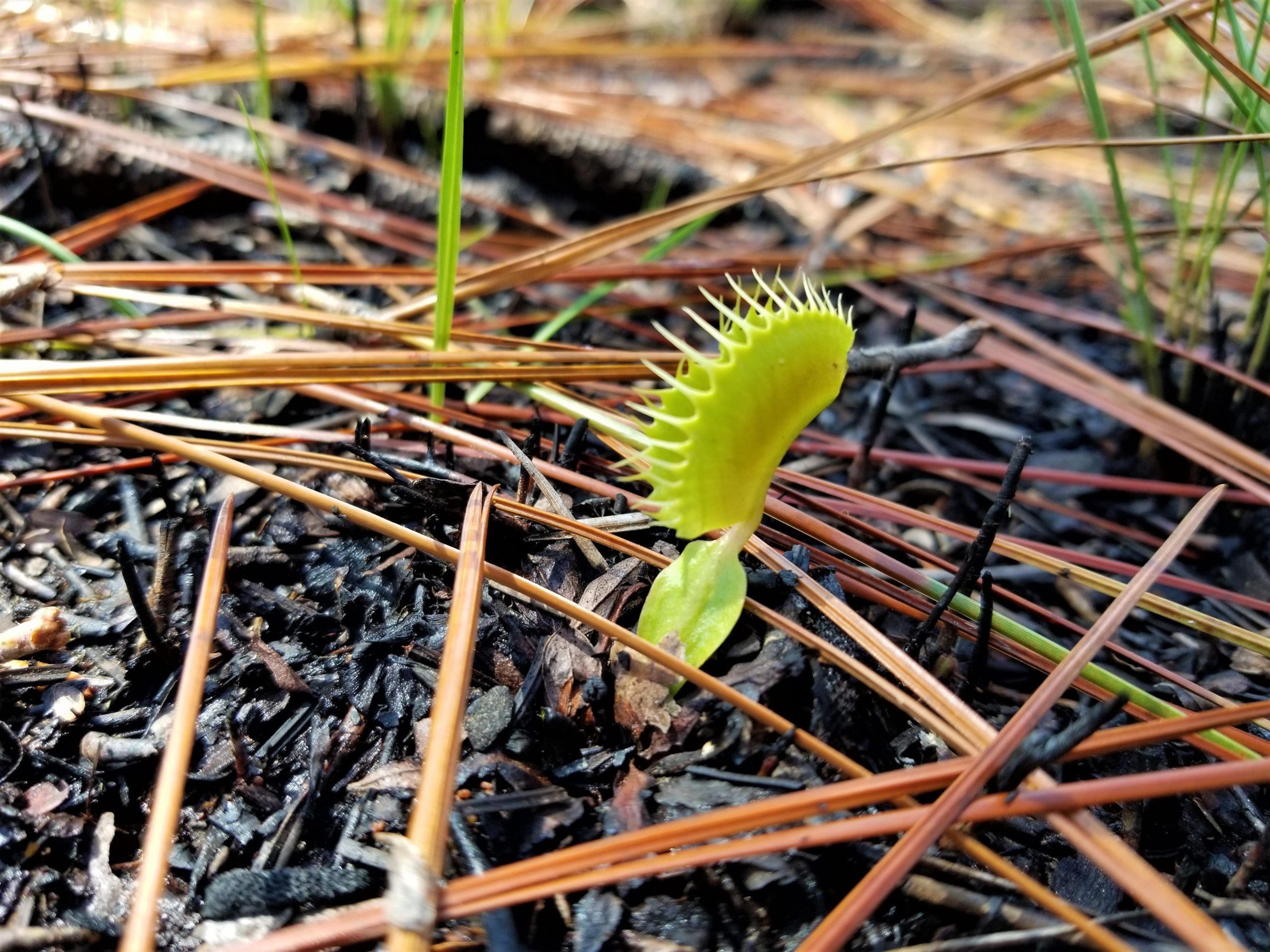
_________________________________________________________________
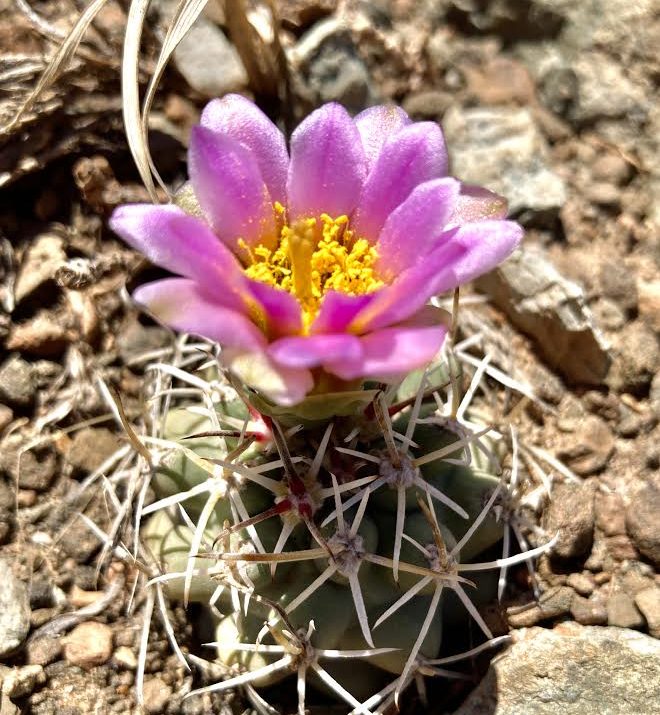
The Colorado hookless cactus (Sclerocactus glaucus) can be difficult to find in the river alluvium habitat it calls home, in western Colorado and eastern Utah. When not in bloom, the perennial stem tends to be inconspicuous in the coarse gravel—and it can even shrink below the ground during large stretches of the year—making these plants hard to spot and identify. Fortunately, this federally threatened cactus produces striking pink flowers from April to May. Nearly all populations are threatened with habitat destruction or modification from energy extraction developments, water storage projects, transportation, and residential facilities. Other ongoing threats include impacts from operations to collect moss-rock and rip-rap, illegal plant collection, and damage from recreational use or livestock trampling.
Colorado hookless cactus is safeguarded in the CPC National Collection at Denver Botanic Gardens, which maintains a seed collection and has established macroplots of populations to monitor demographic trends as part of its conservation efforts to save this species from extinction.
Sponsor Colorado Hookless Cactus!
_________________________________________________________________
Fernald’s northern rockcress (Braya fernaldii) makes its home in limestone barrens on Newfoundland’s Great Northern Penninsula, frequented by freezing winds and neighbored by the icy Atlantic. Among other threats, Fernald’s northern rockcress’s limited habitat is frequently quarried for gravel and driven over or trampled by recreational vehicles and their drivers—but the species is fortunately capable of recolonizing human-disturbed areas. These recolonized populations, however, are often more densely populated and contain larger individuals, leading to new threats: attracting invasive pests like the diamondback moth, an agricultural pest, and fungal pathogens.
This endemic rockcress species is stewarded in the CPC National Collection by the Memorial University of Newfoundland Botanical Garden (MUNBG). To properly secure and conserve this rare plant ex situ, teams from MUNBG must be careful when collecting material from wild populations. Healthy seed needs to come from healthy plants. Pathogen research allows MUNBG scientists to ensure they collect from uninfected individuals and bring back disease-free seed.
Sponsor Fernald’s Northern Rockcress!
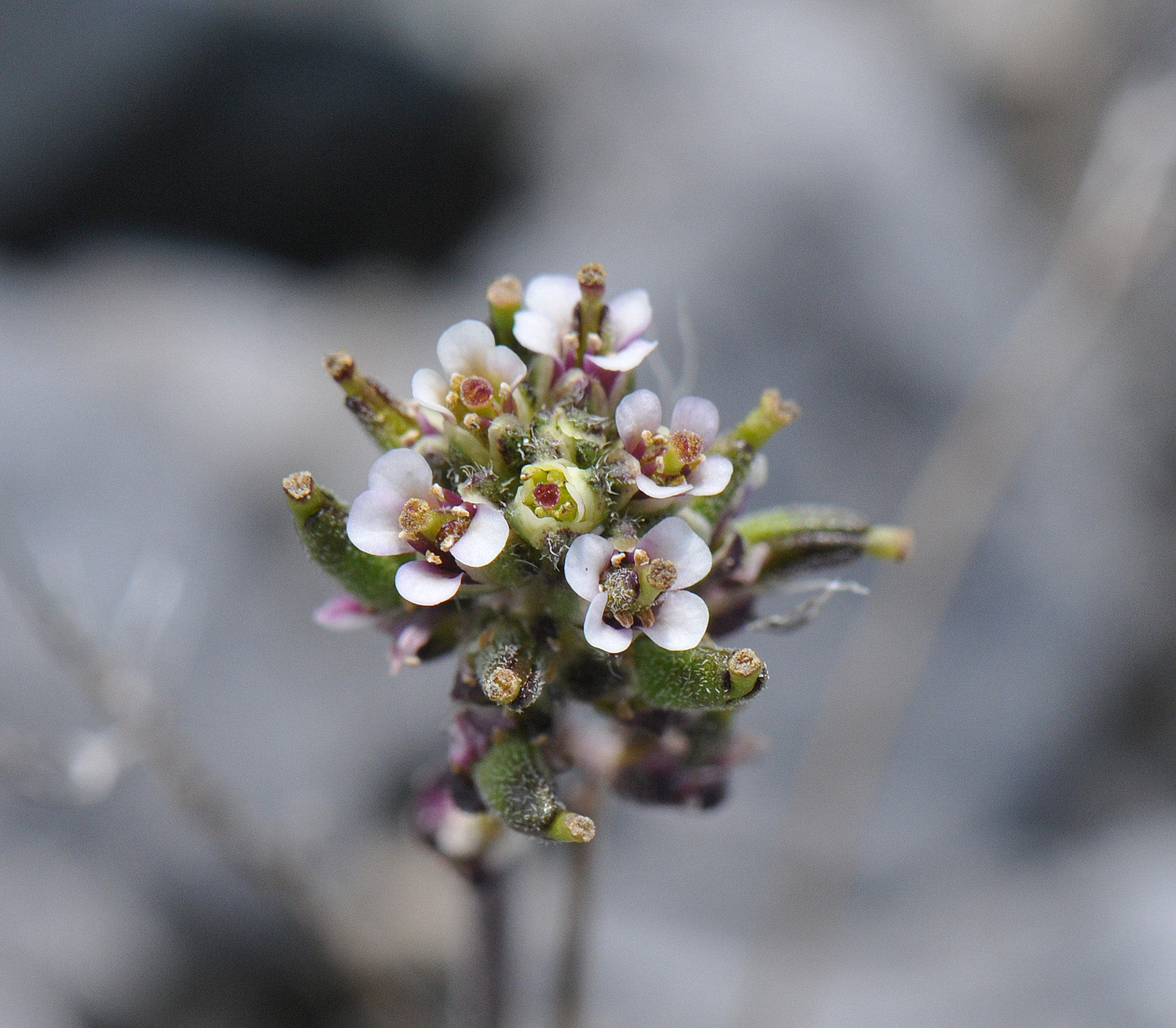
_________________________________________________________________

Cedros Island Oak (Quercus cedrosensis) is an imperiled oak species native primarily to Cedros Island in Baja California, Mexico, with one population occurring at Otay Mountain in San Diego, CA. Major threats to this species include drought, wildfire, and border activities. Oaks are exceptional species—meaning they cannot be stored using traditional seed banking methods—and are often conserved in living collections or other forms of long-term storage, such as cryopreservation. In 2017, only one individual of Quercus cedrosensis was known to be held ex situ in a conservation collection.
Now, Quercus cedrosensis is secured in the CPC National Collection at San Diego Botanic Garden (SDBG), San Diego Zoo Wildlife Alliance, California Botanic Garden, and The Huntington. Genetic material from this species at the Otay Mountain population has been collected in the form of cuttings and a few acorns, grown as a living conservation gene bank by San Diego Botanic Garden, with seedlings held in their nursery and distributed to The Huntington. Seeds from this species are hard to come by, as many wild individuals produce few to no acorns—making cuttings a helpful tool for conservation collections.
Sponsor Cedros Island Oak!
_________________________________________________________________
These endangered plants all need your support! We invite you to learn more about our 40th anniversary campaign and its selection of 40 incredible imperiled plants, for which we are raising funds to support their ongoing conservation and to ensure their survival for generations to come.
Learn how you can sponsor a plant and help save them from extinction.
Don Falk
Throughout the year CPC, highlights individuals from our network who are doing meaningful work to save plants from extinction. Known as our Conservation Champions, these practitioners and conservation advocates are at the forefront of our fight to save imperiled plants–protecting plants and our planet for the benefit of all. Our January Conservation Champion is someone who has been a part of our organization’s journey from the very beginning: CPC co-founder, Dr. Don Falk. As graduate students in the early 1980s, Don and fellow CPC co-founder Frank Thibodeau had the visionary idea to establish an organization dedicated exclusively to rare plant conservation and helped develop partnerships and collaborations that have shaped and contributed to the long-term success of CPC. Following 10 years with CPC, including serving as our first Director, Don moved into the field of restoration ecology studying Ecology and Evolutionary Biology at the University of Arizona, where he now serves as a Professor in the School of Natural Resources. We are immensely grateful to Don and all those who supported and believed in the vision for CPC forty years ago–thank you for your work to save plants!
When did you first fall in love with plants?
Growing up, I spent much of my time outdoors in Pennsylvania and during summers in New England. I loved the solitude of being out in the woods and listening to the sounds of nature. As time went on, I started paying closer attention to the details, and as I learned to identify what I was seeing while out in nature, it was always plants that captured my attention. By my 20s, I had formed a deep and lasting bond with the natural world. It wasn’t an intellectual endeavor at first, it was just where I wanted to be and spend time.
Plants have always been a means for me to see something bigger than myself, and even human society. They are a vivid reminder of the diversity of life that surrounds and sustains us. The more attention we pay to how miraculous plants are—how they work to capture and store energy, the key ecological roles they play, their role as food sources, and more—the more remarkable they become. They are quiet and humble, yet so extraordinary. As I started to study plant science, I had many astonishing moments understanding how miraculous plants are, and the amazing role they play for the entire planet.
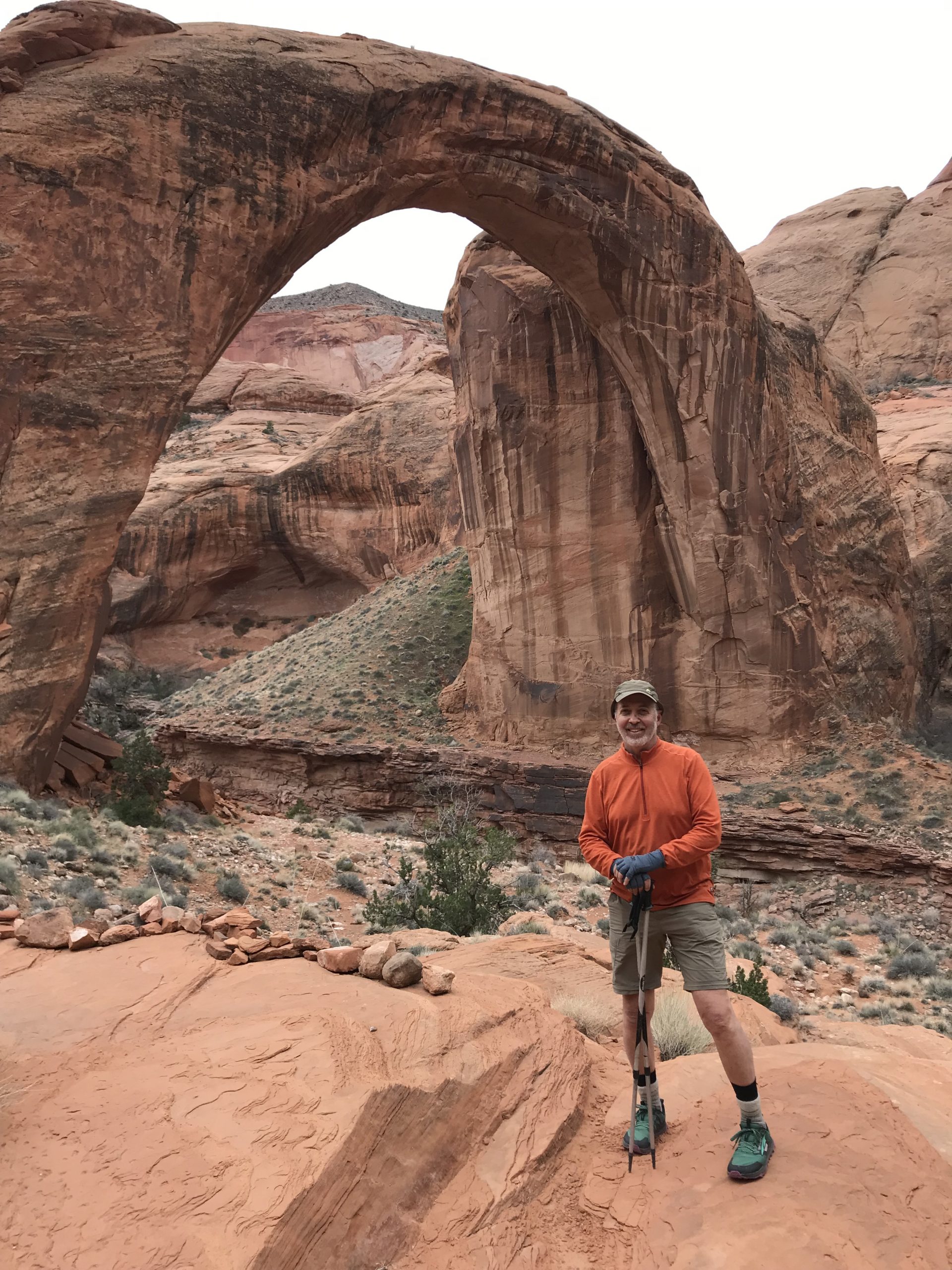
What was your career path to CPC?
Turning my passion for plants into a career really developed when Frank Thibodeau and I were friends and graduate students at Tufts University. We were both interested in what, at the time, people were calling conservation strategies. That is, we asked: how can we develop approaches to conservation that were not simply reactive but could instead get us ahead of the game. We did our own informal gap analysis to assess the areas of need in conservation programs. It didn’t take us long to recognize that a major gap in conservation programs at the time was the lack of emphasis on plant diversity. It really astounded us that the organisms that are the foundation for all life on Earth were not represented in the conservation field to a degree commensurate with their importance. At the time, most conservation groups were working to protect places or charismatic animals, which was and remains absolutely essential, but plants had strangely been left off to the margins.
We decided to help fill that need and saw it from an entrepreneurial perspective–an opportunity to do something new, different, and interesting. Organizations like IUCN, World Wildlife Fund, and The Nature Conservancy all had programs that were beneficial to plants in certain capacities, and the Endangered Species Act had passed in 1973, so it’s not that plants were being neglected entirely, they just weren’t the central focus of any organization at that time.
It’s profoundly important to acknowledge that we didn’t do this work alone. CPC would not have happened if it weren’t for the help of many people, including the founding Board members Richard Phippen, Bill Truslow, Phebe Miner, Hal Coolidge, Elliot Forbes, George McCully, and Joe Breiteneicher. Other key early Board members included Mary Ann Streeter, Dorothy Wallace, Mary and Sam Cooke, Bob Blucke, Patty Bush, Marty Rosen, Janet Poor, Paul Hawken and Bob Cook.
In the same way, the leaders of our early group of botanic garden and arboretum affiliates were absolutely key to building the organization, including Peter Ashton (Arnold Arboretum), Bill Brumback (New England Wildflower Society), Jon Shaw (NEWFS and Bok Tower Gardens), Peter White (University of North Carolina Botanical Garden), Robert Breunig (Desert Botanical Garden), Keith Woolliams (Waimea Arboretum), George Briggs (North Carolina Arboretum), Brian Parsons (Holden Arboretum), Tom Elias (California Botanic Garden) and of course Peter Raven at Missouri Botanical Garden. Some key plant conservation scientists joined our Advisory Council to provide scientific guidance, including Bob Jenkins, John Fay, Bob DeFilipps,Tom Lovejoy, Grenville Lucas, and Bruce MacBryde. People in the funding community, such as Bill Robertson at Andrew Mellon Foundation, and Hank Foster at W Alton Jones Foundation, and many others including the MacArthur, Pew, Dodge, Gund, Hewlett, Surdna, and Packard Foundations were willing to believe in the idea, and I think we did well by them. Organizing and engaging support for this new organization and this common goal to conserve rare plants was a large part of our job in the early days of CPC. That task was carried forward by a very dedicated staff, including Linda McMahan, Kerry Walter, Peggy Olwell, Mike O’Neal, Nancy Gibson-Nash, Linda DeBruyn, Jenna Klein, Golda Kagan, Pam Thompson, and many others. And of course, we have been hosted generously by very distinguished institutions, including the New England Wildflower Society (CPC’s original organizational host/financial custodian), the Arnold Arboretum of Harvard University, Missouri Botanical Garden, and now the San Diego Zoo Wildlife Alliance.
By the way, it’s fascinating to note that at our first Board meeting in 1984, we set a goal of having roughly 10% of species that were then thought to be endangered in protection. With over 2,600 species now in the National Collection, CPC and its collaborators have achieved much more than that! In addition, I’m also proud that we played a key role in establishing plant conservation networks in Australia and China on the CPC model.
CPC was really grown by a good-sized village–board members, staff, Participating Institutions, and funders–an entire community who helped build it from the original core idea to bring people and plants together.
What have you been doing since leaving CPC?
During my ten years of more or less total immersion in CPC and rare plant conservation, I was intrigued by the relationship of rarity to the quality of habitat where plants live, so much of which was increasingly degraded. This brought me into the field of restoration ecology, which is the art and science of healing damaged ecosystems. I was involved early in the formation and growth of the Society for Ecological Restoration (SER), and later became their first Executive Director. Like CPC, SER is the main professional organization for people in the field; they also publish the lead journal, Restoration Ecology, and hold annual national and international conferences. This felt like a very natural progression, from protecting individual plant species to restoring their habitat.
Eventually, I decided it was time to return to graduate school for a PhD, which I had literally been too busy for since CPC began. By now, I was also married to botanist Mima Falk and had started a family. I ended up selecting the University of Arizona where Mima was working for the Coronado National Forest, and I pursued my degree in Ecology and Evolutionary Biology, using tree-rings at the venerable Laboratory of Tree-Ring Research to reconstruct historic fire regimes in the Southwest. After graduating I was hired as a faculty member and have been at UA ever since. Increasingly my work focuses on forest resilience: what gives forested ecosystems the ability to adapt to climate change, severe wildfires, and other stressors? I collaborate with scientists all over the country who are interested in this question, including practitioners and holders of Indigenous Knowledge about the cultural practices that maintained what we now think of as old-growth ecosystems.
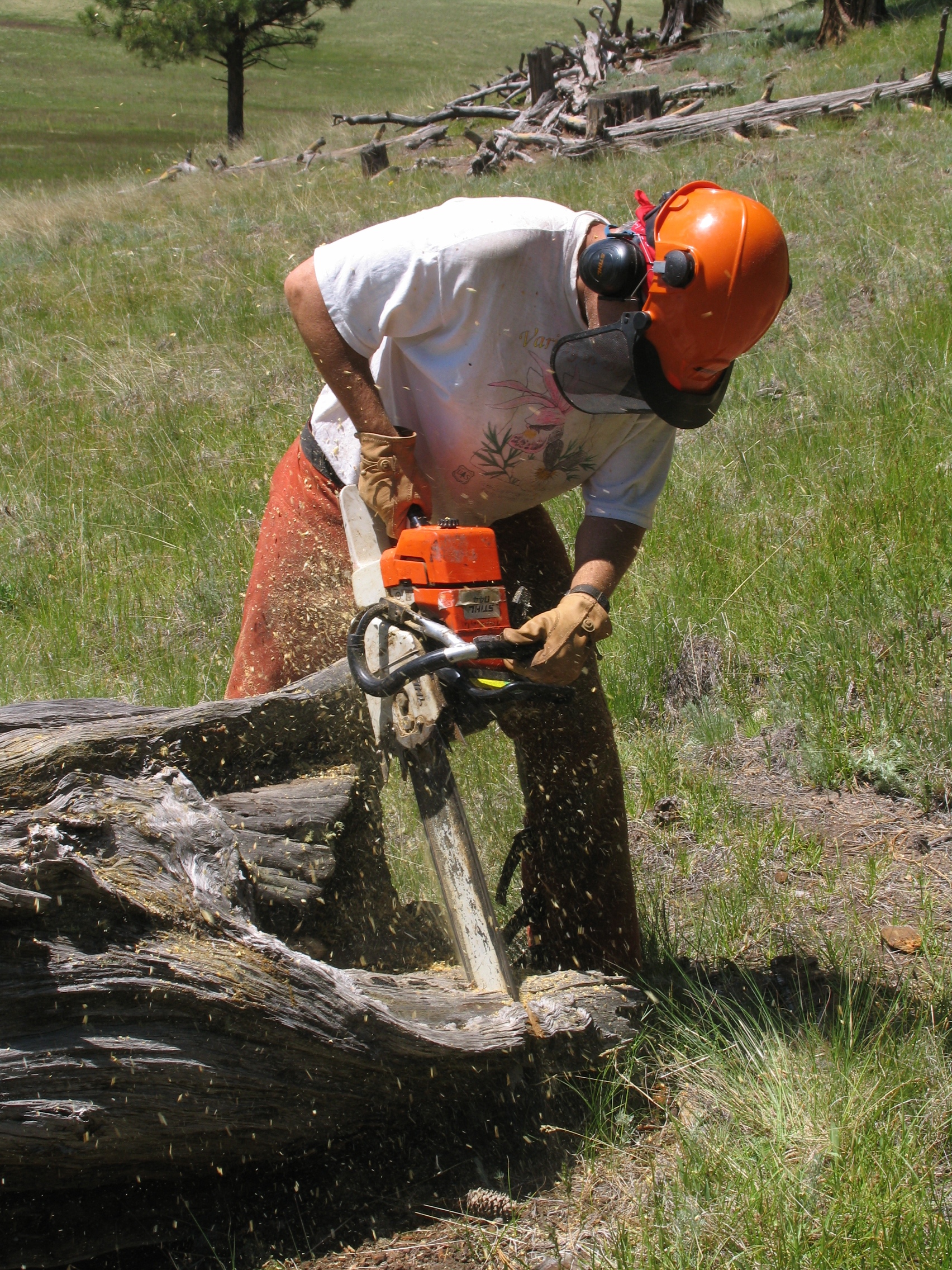
In your experience, how has the field of plant conservation changed in the 40 years since CPC’s founding?
In conservation generally, but certainly for plants, the threats to nature have become more generalized, rather than localized and site-specific. At the time, for example, we were more concerned the development of a natural area into a shopping center or highway, or some localized source of agricultural runoff, or over-collecting of plants. This doesn’t mean we weren’t aware of climate change, invasive species, and other more generalized threats, but they weren’t at the forefront of our thinking at the beginning. Even at the beginning, CPC started asking what we could do to preserve multiple populations of a species of concern, and how genetically different those populations were. This question of genetic diversity within and among populations led to a conference at Missouri Botanical Garden in 1989, and subsequently to the first book on the genetics and the conservation of rare plants (Genetics and Conservation of Rare Plants, Falk and Holsinger, Oxford University Press 1991). This was a big step for CPC into the underlying science of plant conservation, and it was gratifying to have leading geneticists contribute to that and the work that followed, such as the first rare plant collection guidelines based on population biology. I feel enormously proud that CPC helped open the door to rare plant conservation genetics at the time.

Other more systemic threats have come into the picture since CPC began, particularly the increasing area affected by wildfire, the adverse impacts of invasive plants, and the pervasive effects of climate change. With climate change, we can no longer assume that protecting a plant population at a particular location is a sustainable strategy, because those sites may become unsuitable over time. Probably the biggest strategic shift in the world of plant conservation at present is the recognition that reintroduction and translocation need to be part of the strategy in some cases. CPC was ahead of the curve on this topic with our book on rare plant reintroductions (Restoring Diversity, Falk, Millar, M Olwell, Island Press 1996), and CPC’s botanic garden partners are perfectly positioned to play a role in this strategy because they have the ability to study and grow the plant material.
We never wanted botanic gardens to be the only home for the plant material, although of course we wanted to have long-term seed banks, and it’s amazing to see how that technology has developed and grown. In my view, the ultimate role of CPC is to complete the circle and help get the plants back out into the wild; we called this “integrated conservation strategies.” Beyond that, the member botanical gardens and arboreta provide an exceptionally effective role in public education, which has always been one of the pillars of their work. As the challenges to plants have shifted, we now require different solutions. CPC is positioned to play a unique contributory role in this new plant conservation landscape.
What emerging initiatives, technologies, etc. are you most excited about for the future of conservation?
Plant genetics has advanced greatly since the early days of CPC, allowing us to better understand how much variation there is among a species, and their ecological and evolutionary context. This line of research lets us look under the hood of a species–what makes it tick, and how it operates–which is key to conservation because we have to understand how a plant operates in the world ecologically and what its niche is. We have much more advanced tools today versus 40 years ago to better understand ecological genetics, but there’s still a great need to research and apply it to all the endangered plants of the U.S.
The near-term future of conservation is not so much about technology as it is about how and where to apply the tools we have. What I mean by that is the role of CPC in helping ensure a future for rare plants in the wild, not only in seed banks and botanic gardens, but also getting species back to stable footing in the wild. That means enhancing or reintroducing populations, or looking to put species in a habitat where they haven’t been recorded before, but where the habitat is suitable now or becoming suitable due to climate change. These are important advances in the field of plant conservation.
What has surprised you about working with and learning more about rare plants?
I’d say it has to do with evolution. We often hear people say rare plants are on their way out, they’re dying out because they don’t have the capacity to survive in our world. This implies that rare species are old, adapted to some earlier environment. What intrigues me is that there’s a very good chance that many of the rare plants we see are, in fact, newly evolving species. Young species are by definition rare at the beginning of their evolutionary divergence; then they expand to become more abundant. We don’t know how many rare species today are newly evolving, suggesting they are at the leading edge of evolution, not the trailing edge. It takes a lot of hard work on the evolutionary biology of a species to answer this question, but the possibility is intriguing that some of these species represent the leading edge of evolution and an essential element of conserving biodiversity.
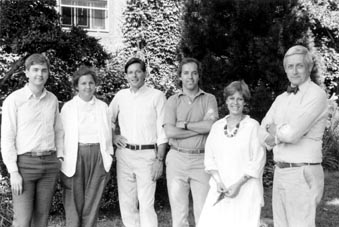
What advice would you give to those who wish to learn more about conservation and how they can help save imperiled plant species?
I’ll answer by going back to where Frank and I were at the very beginning and say trust your ideas and trust your instincts. If you see something interesting that you think nobody else is doing and that you think is worth exploring, then don’t be talked out of it too easily. We could have easily concluded (and in fact were told by a number of distinguished people we consulted) that the idea for a plant-centered organization wasn’t going to work. Luckily, we didn’t listen to that advice. You have to be passionate and be willing to try something new, even with the possibility of failure.
Another important lesson from the work that Frank and I did in the founding of CPC is not to try to go it alone. Find friends, partners, and colleagues who see the world the same way you do, and who want to try solving the same kind of problem and build yourself a community. This has really been a strength of CPC all along–it wasn’t just two graduate students who thought they had a promising idea; it was and remains the creation of countless people who contributed to this idea and made it better.
Reminder: Catherine H. Beattie Fellowship Application Deadline Coming Soon
Each year, The Garden Club of America (GCA) and the Center for Plant Conservation together award the Catherine H. Beattie Fellowship to graduate students in biology, horticulture, or a related field. The purpose of the award is “to promote conservation of rare and endangered flora in the United States, with preference given to students whose projects focus on the endangered flora of the Carolinas and southeastern United States.” The fellowship was established to honor Catherine H. Beattie, who served as a director and board member of the GCA and as president from 1981 to 1983.
The fellowship provides one annual research grant of up to $4,500. The grant is regarded as compensation for work at a botanical garden by the student, who jointly serves the program of the Center for Plant Conservation and their curricular studies. For 2024’s fellowship recipient, an additional $500 stipend will be included to defray the cost of attendance to a conference of their choice.
We are now accepting applications for 2024 fellowships. Please visit CPC’s website for more information about the Beattie Fellowship and detailed application instructions. Applications are due January 31, 2024.
Learn more and apply.
National Collection Spotlight: Ruby Valley Buckwheat
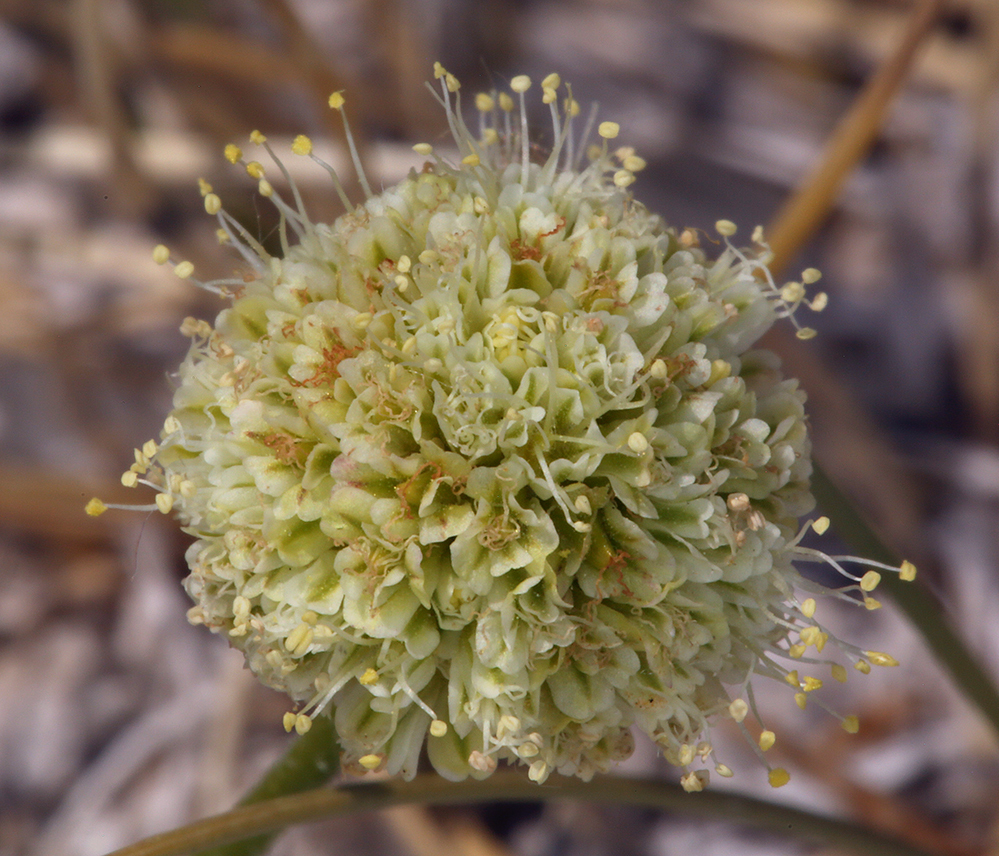
Ruby Valley Buckwheat (Eriogonum argophyllum) is a critically imperiled buckwheat endemic to a single valley: Ruby Valley, Nevada. This Nevada endemic species sports a brilliant spherical yellow flower, much like the silhouette of a firework—a perfect choice to ring in the New Year. Ruby Valley Buckwheat is protected by the state of Nevada, and the one population known to exist is on private land. Although past threats to this species included potential geothermal development and recreational activities, a cooperative agreement with the private landowner has helped to mitigate risk and protect Ruby Valley Buckwheat.
Eriogonum argophyllum is secured in the CPC National Collection at Red Butte Garden in Salt Lake City, Utah, and the National Laboratory for Genetic Resources Preservation (NLGRP). In 2011, Red Butte Garden collected seed from the only known population of this species for storage at their seed bank and at NLGRP. Red Butte Garden staff have also germinated seed from this rare plant and grown seedlings to maturity in their greenhouse.
Learn more about conservation actions taken for Ruby Valley Buckwheat on its National Collection Plant Profile, and help support critical conservation work for this species at Red Butte Garden with a Plant Sponsorship.
As Seen on CPC’s Rare Plant Academy: Genetics Metrics Used in Rare Plant Conservation: A Primer for Non Experts
The Rare Plant Academy (RPA) Video Library brings to life the principles and techniques described in CPC’s Best Plant Conservation Practices, a compilation of expertise and knowledge from CPC’s wide network and 40-year history. To keep up with rapidly evolving technology and science, the CPC Best Practices constitute a “living” document that is reviewed and updated periodically. The RPA Video Library is home to many informational videos on plant conservation topics, from educational videos to case studies to recorded conference presentations.
“Genetics Metrics Used in Rare Plant Conservation: A Primer for Non Experts” was created for the Rare Plant Academy with contributions from Dr. Christy Edwards and Brock Mashburn of Missouri Botanical Garden. The goal of this video is to introduce the genetics metrics commonly found in rare plant conservation papers. Genetics insights can be critical for managing rare plant populations—but not all professionals with rare plants in their care have a background in genetics, which can make interpreting these studies difficult. Watch this video and search the RPA Video Library to discover more!
Get Updates
Get the latest news and conservation highlights from the CPC network by signing up for our newsletters.
Sign Up Today!Employment Opportunities
The United States Botanical Garden (USBG), Washington DC, has two arborist postions open.
The Arborist will be engaged in contemporary scientific methodology and practices to grow, preserve, and maintain a wide variety of tropical, sub-tropical, temperate, and historical trees at the full performance level. Provides leadership for the implementation of a complete arbor care program for the entire USBG public campus and production facility.
The incumbent develops and grows species, hybrids for cultivars having horticultural and aesthetic impact.
Protects and cares for threatened rare and endangered species and sensitive plants. Performs specialized gardening work involving the propagation, culture, and display of a wide variety of plant species. Prunes and assists in removal of diseased, dead, hazardous and otherwise unwanted trees. Also prunes trees and ornamental shrubs to obtain proper balance between roots and top growth and to modify or retain natural form.
Performs specialized pruning on tropical tree species within the conservatory. Many conservatory plant species are over 50 feet tall and will often grow to reach the conservatory glass ceiling and mechanical systems at nearly 90 feet. These specimens require advanced skilled climbing, pruning, and rigging techniques not often used in the trade. Therefore, the incumbent must be able to safely ascend living arbor specimens without damaging the tree and without the use of aerial lifts. The incumbent must be able to comfortably work at height while learning to overcome challenges aloft.
Creates precedent setting and artistically unique horticultural designs and exhibits and is responsible for the production of the required display crops. Expands and/or develops large and complex living tree collections. Performs collections studies including the exchange of materials, ideas, and information with other conservatories, museums, and botanic gardens.
Adjusts the nutrient content of soil based on prescribed soil test recommendations. Propagates, grows, and plants a wide variety of trees. Makes decisions with Plant Curator on which species to propagate, number of propagules and plans for long term care. Works with the Plant Recorder to ensure all plant information is accurately entered into the USBG living collection database.
Works with the Plant Health Care Specialist to diagnose and control pest infestations and diseases by selecting the proper Integrated Pest Management strategy. Many pest challenges are unique and not common to the trade.
- International Society of Arboriculture (ISA) certification or an accredited tree expert license is required for the WG-10.
- Must possess a valid, unexpired District of Columbia Pesticide Applicator’s License (or a valid State license reciprocal with D.C.) for pesticide license categories 3A, 3B and 3C to apply pesticides.
- Salary
$31.91 – $37.28 per hour
- Pay scale & grade
WG 10
For more information and to apply please see the announcement found here: USAJOBS – Job Announcement. The job closes on 1/29/24
The Atlanta Botanical Garden invites applications for the position of Senior Collections Technician (1) and the Collections Technician (2) in the Southeastern Center of Conservation within the Department of Conservation & Research at the Atlanta Botanical Garden. The successful candidate will work under the direction of the Research Scientist, Genetics. This position is necessary to complete the objectives of the Institute of Museum and Library Services funded project, “Safeguarding the Atlanta Botanical Garden’s Conservation Collections”.
https://recruiting.paylocity.com/Recruiting/Jobs/Details/2166179
https://recruiting.paylocity.com/Recruiting/Jobs/Details/2166167
Lauritzen Gardens is seeking a dedicated leader to serve as its Chief Executive Officer (CEO) upon the planned retirement of the current Executive Director. The Garden seeks a mission-aligned and visionary leader to join the organization at a pivotal juncture and help shape its promising future.
As the Garden’s chief ambassador, the CEO will report to and liaise directly with the Board of Directors, undertaking roles ranging from strategic planner to innovator, and from relationship-builder to brand steward. Responsibilities will encompass reinforcing the Garden’s community footprint, ensuring financial stability, and enhancing its brand identity. The CEO will lead a team of nearly 100 professionals bolstered by a dedicated Board of Directors, Board of Trustees, and volunteer cohort with a history of unwavering support for the Garden. The CEO will be focused on actively engaging with the community and Board of Directors, developing new strategic and master facilities, securing the financial health of the organization, recruiting, engaging and retaining staff, developing positive working relationships with all the departments, ensuring a culture of trust throughout the organization, and improving employee engagement overall. This an exciting opportunity for the Garden’s new leader to take the organization to the next level of performance, positioning it as a premier botanical garden in the region and the nation.
Ways to Help CPC

Conservation Advocacy Initiatives
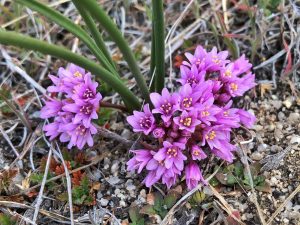
Be an advocate for rare plants like South Idaho Onion (Allium aaseae)!
South Idaho Onion is an imperiled species endemic to grasslands and shrublands in southwestern Idaho. Rare and endangered plants like South Idaho Onion are at risk of extinction due to a multitude of factors, from habitat development to invasive species to climate change. Our network is working hard to Save Plants, and you can help by using your voice. Be a rare plant advocate!
How can you help advocate for rare and endangered plants? Stay informed, contact your representatives about legislation related to conservation, and involve your friends and family!
On the Advocacy page of our website, you can find federal legislation in the U.S. that the CPC is tracking with a direct effect on rare plant conservation. You can also read CPC’s Position Papers and learn how you can help be your best endangered plant advocate.
For more information and more ways you can help, check out the Get Involved tab on CPC’s website. In addition to rare plant advocacy, you can learn what it means to be a Plant Sponsor and sign up for our newsletter to receive monthly conservation updates from the CPC network.
Photo credit: Allium aaseae with flowers in situ in Idaho. Photo by Micah Lauer.

Donate to Save Endangered Plants
Without plants, life as we know it would not be possible. Yet two in five of the world’s plants are at risk of extinction. More than ever before, rare plants need our help!
When you support the Center for Plant Conservation (CPC) by making a charitable gift, you help advance our mission to safeguard rare plants by advancing science-based conservation practices, connecting and empowering plant conservationists, and inspiring all to protect biodiversity for future generations.
Your donation makes it possible for CPC to offer educational resources that support and train our botanical community, advance science-based conservation research, maintain the National Collection of Rare and Endangered Plants, and so much more.
The Center For Plant Conservation is a 501 (c) (3) non-profit organization (EIN# 22-2527116). Your gift to the Center for Plant Conservation is 100% tax deductible.
Your gift ensures CPC’s meaningful conservation work will continue. Together, we save more plants than would ever be possible alone—ensuring that both plants and people thrive for generations to come. We are very thankful to for all that you do to help us Save Plants!
Donate to CPC
Thank you for helping us save plant species facing extinction by making your gift to CPC through our secure donation portal!
Donate Today